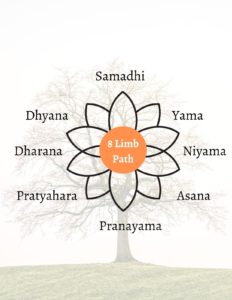Yoga is for Everybody!
Every time I hear someone utter those words “I’m not flexible, so I can’t practice yoga” I physically react, shake my head and utter “Yoga is for every BODY.”
In 2000, I began my asana practice of yoga in Washington, DC. In 2017, 15+ years after my first class, I reluctantly signed up for my first 200-hour Yoga Teacher Training. And even as I handed over my deposit, I had doubt. Who am I to teach yoga in a body that does not fit the ideal yoga body? No one said this to me, but this idea lingered in my thoughts until I finally told it to shut up.
What is Yoga?
 Yoga is so much more than the pose, asana, or how you bend your body. In my first 200-hour Yoga Teacher Training, I learned about the Eight Limbs of Yoga, and all yoga has to offer. As we studied each limb of the path, I learned how yoga is more than poses, but also includes (Yama) social observances, (Niyamas) regulating oneself, (Asana) poses or postures, (Pranayama) breath, (Pratyahara) use of sense, (Dharana) concentration, (Dhyana) meditation, and (Samadhi) obtaining a state of bliss. So yoga is much more than asana or yoga poses alone.
Yoga is so much more than the pose, asana, or how you bend your body. In my first 200-hour Yoga Teacher Training, I learned about the Eight Limbs of Yoga, and all yoga has to offer. As we studied each limb of the path, I learned how yoga is more than poses, but also includes (Yama) social observances, (Niyamas) regulating oneself, (Asana) poses or postures, (Pranayama) breath, (Pratyahara) use of sense, (Dharana) concentration, (Dhyana) meditation, and (Samadhi) obtaining a state of bliss. So yoga is much more than asana or yoga poses alone.
“Yoga is not a work-out, it is a work-in. And this is the point of spiritual practice; to make us teachable; to open up our hearts and focus our awareness so that we can know what we already know and be who we already are.” — Rolf Gates
Where Did All of the Yoga Poses Come From?
Yoga’s roots are Southeast Asian with an Indus Valley civilization artifact dating back to 2500 BCE providing evidence of an early yoga practice (Mark Singleton, Yoga Body: The Origins of Modern Posture Practice). The Yoga Sutras of Patanjali are estimated of being created around 5,000 BCE to 300 AD. Yoga is old, but during the time it has existed, people have innovated by adding poses, new pranayama, even different interpretations of The Yoga Sutras of Pantajali.
How Do I Incorporate Yoga into My Daily Life?
First, remove the idea of “practicing yoga is only practicing the poses.” Review the Eight-Limbed Path and bring your focus inward. Start with your moral code. Reflect on your true nature and ask yourself these few questions.
- When do I cause harm?

- When do I take things that are not mine, physically taking, or energetically stealing?
- Am I truthful each day in my interactions with others, or am I truthful to myself?
- Am I generous, with my time, energy, offerings?
- Am I seeking to find a balance in my life?
- Am I aware of abundance and when I am fulfilled?
- Am I always seeking more?
Journal, meditate, read or simply acknowledge these questions. Start where you are, and begin to evaluate your moral code. Continue sequentially along the Eight-Limbed Path, or hop around as you need. The path is not linear, and you can revisit any of the elements at any time. Even if you have reached Samadhi you can still come back to identifying your moral code and practice yoga in your everyday life.
The article was specially written by Courtney Gendron for You Call This Yoga.
